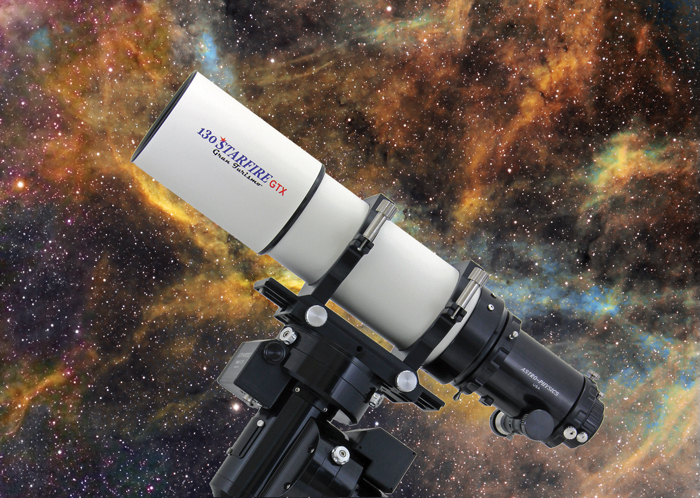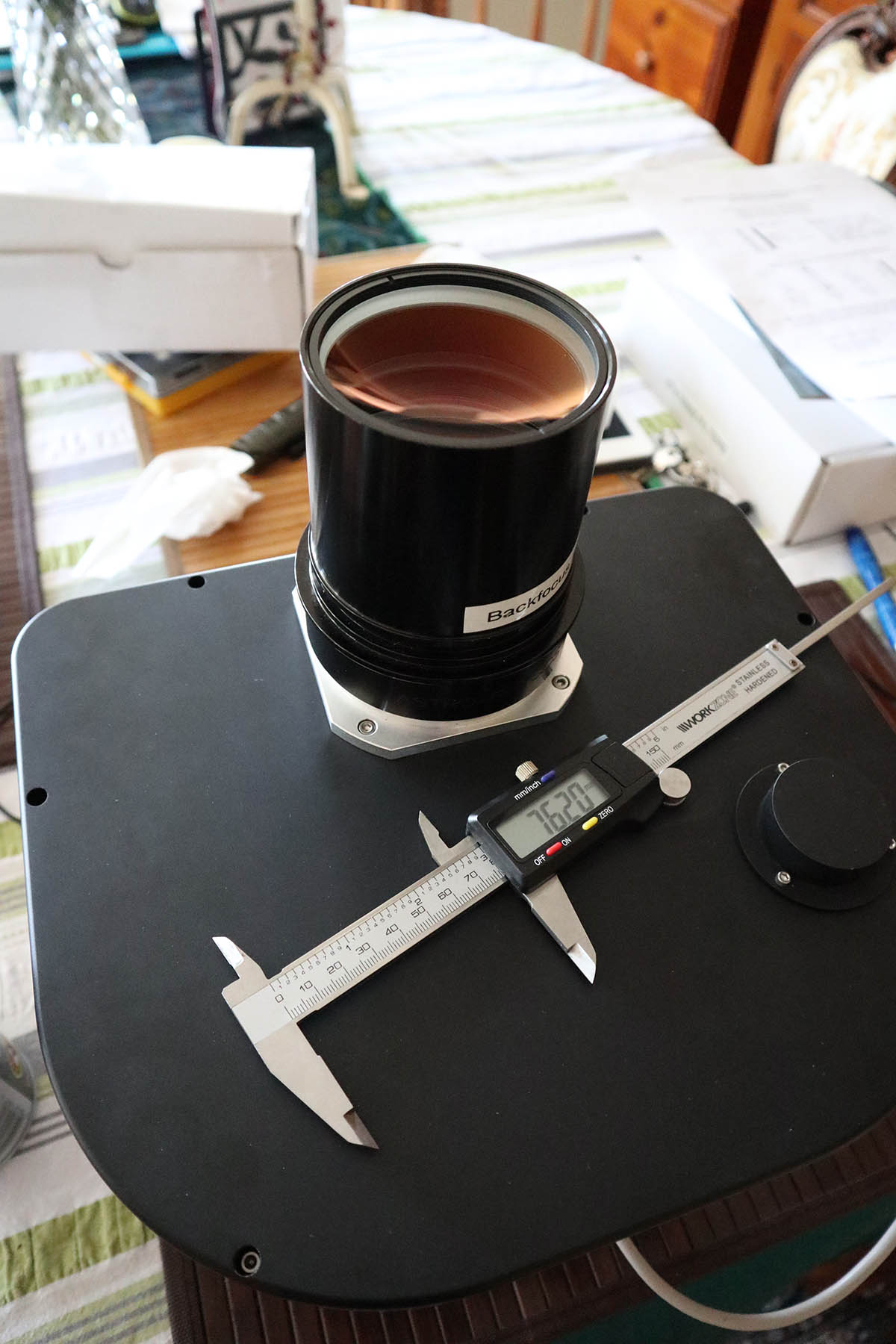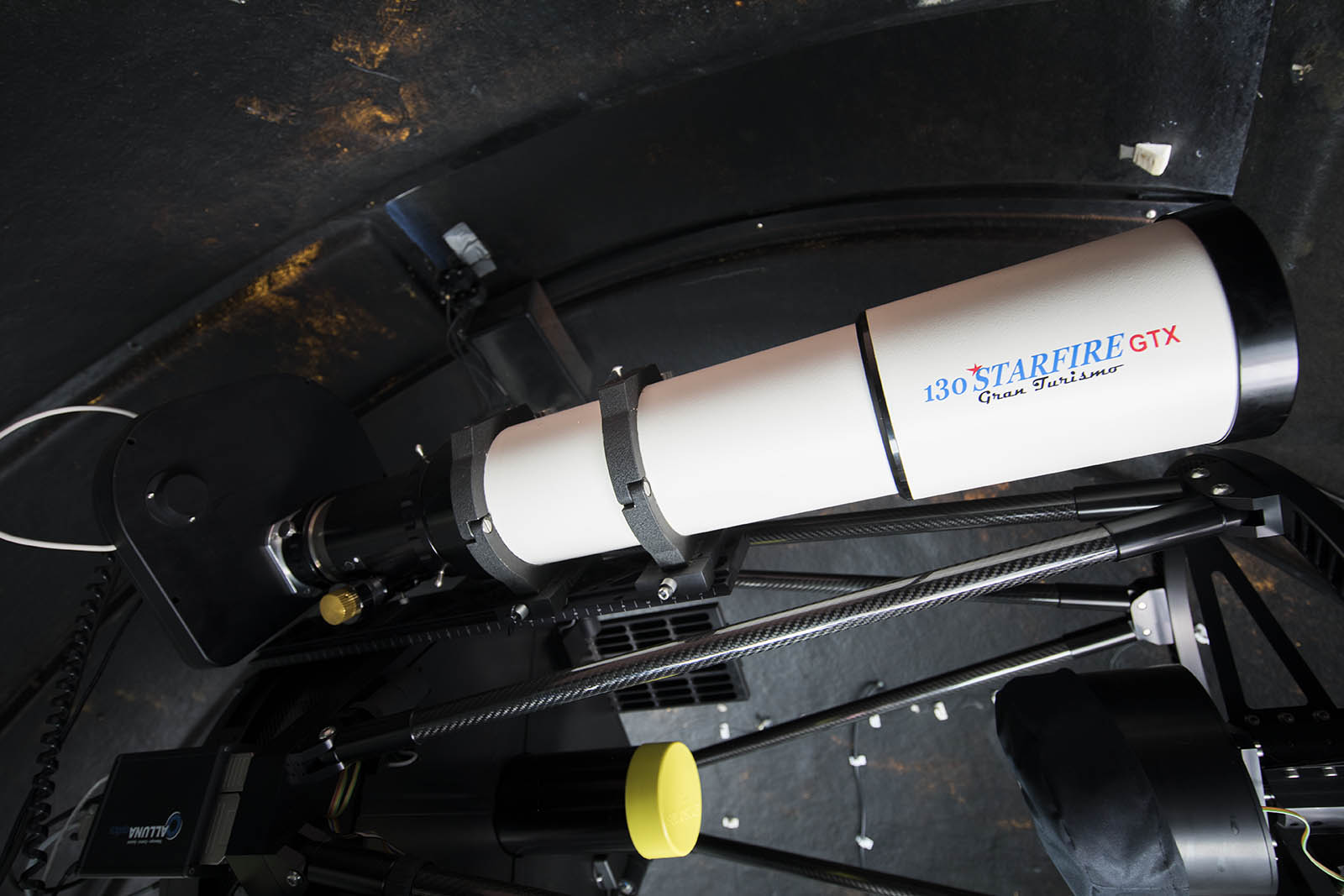
Astro-Physics 130mm F6.3 Starfire GTX

Specifications
| Color correction | Less than + - 0.006% focus variation from 706nm to 400nm (red to violet). |
| Clear aperture | 130mm (5.12") |
| Focal length | 819mm (32.25") |
| F/value | f/6.3 |
| Theoretical Resolution | 0.87 arc seconds |
| Coatings | Multi-layer, broadband, overall transmission greater than 97% in peak visual wavelengths |
| Magnification range | 22x to 500x |
| Tube assembly | Cream white, 5.5" diameter, machined aluminum tube, fully baffled, flat black interior, engraved retaining ring. Convertible for travel. Optional covers to protect the lens and tube when it is disassembled. |
| Focuser | 3.5 " I.D. Focuser with rotating collar with "captain's wheel", rack and pinion, FeatherTouch Micro 9:1 dual-speed reduction, 4.5" travel; 7.3" backfocus, 2.7", 2" and 1.25" adapters. Focuser drawtube features mm focusing scale. |
| Telescope length | 724 mm (28.5") with dew shield fully retracted; 864 mm (34.0") with dew shield fully extended. Optical tube with covers for airline travel is 21.0” (533 mm); focuser with cover and adapters is 11.0" (280 mm). |
| Diameter of dewcap | 155 mm (6.1") O.D. including paint thickness, retractable |
| Weight with dewcap | 18 lbs. (8.2 kg) |
| Carrying case | Wood case with grey vinyl covering and foam-lined interior. |
Test Images and FSQEDXIV "mouse over" image comparison
Above 600 second H-alpha exposure SBIG STX16803 CCD at 50% resolution. No cropping.
Image taken with AP's Quad-telecompressor, yeilding an effective focal length of 580mm
Rollover image: 900 second H-alpha exposure SBIG STX16803 CCD and
Takahashi FSQEDXIV Focal length of 530mm at 50% resolution. No cropping.

Above: In both price and size, the AP Quad compressor is a serious optic.
Subsequent measurement of a custom Precise Parts adapter put the CCD focal plane at 103.2mm
..just 0.4mm off the design sepcification distance of 102.9mm.

Above: The AP 130 Starfire GTX is fitted with 3.5" Internal diameter 10:1 focuser.
It easily handles large cameras such as the SBIG STX16803/FW5 fitted with 65mm filters
Above 100% resolution image showing extreme corners of the SBIG's 16803 sensor and center of frame
Rollover image show the extreme corners and center of the FSQ106 EDX IV
Note: No attempt was made to "sqaure on" the CCD camera to either telescope
Slight left edge defocus/star-elongation in the FSQ was due the heavy camera payload causing a small tilt in the focuser.
Some observations on the Astro-Physics 130mm F6.3 Starfire and Takahashi FSQ106 EDX IV
Astro-Physics and Takahashi make simply some of the best telescope optics available. Period.
Apart from the obvious (aperture and focal length) there are two main differences between these two telescopes.
The AP has a superior focuser which easily and precisely lifts seriously heavy camera assemblies (e.g. SBIG STX16803 or FLI Proline 16803) while the FSQ struggles.
The FSQ shows a tiny amount of tilt/sag and is prone to slip, particularly if the focus-lock tension is even slightly out.
The FSQ is also something of a "one trick pony".
Make no mistake: it delivers an absolutely superb, fully corrected wide field vistas out to the very edge of its massive 88mm imaging circle (The AP with field flattener is 65mm) and does so with perfection, using even the largest sensors currently available.
But with a complicated range of adapters ( including adapters for adapters!) smallish aperture and short focal length it doesn't lend itself to much else. However, that one, very impressive trick, lets you cover vast amounts of sky to create images that would be a challenge to capture using anything else.
While it covers only marginally less sky than the FSQ, the AP130 GTX (with the Quadreducer) is more versatile:Exposure times can be reduced, as it gathers over 50% more light than the FSQ106 (25 vs 16 square inches) . Using AP's Barlow and QuadReducer, you can switch between 1640mm, 820mm and 580mm focal lengths in seconds, to give scale to, or frame an object with a minimum of fuss, with no absolutely no compromise to image perfection . There is one terse proviso. Focal plane spacing from both the field flattener and Qual reducer needs to be within 1 mm of the design figure. Custom adapters do not come cheaply, and care should be taken to get the spacing numbers absolutely right.
So what happens if you get the spacing wrong? The image below shows the extreme corners and center of an image taken with AP's Quadreducer and a 22mm spacing error.
Availability is another problem. A Takahashi FSQ106 can often be purchased ex-stock from many vendors.
Not so with Astro-Physics. Demand is so high that there is a waiting list on their telescopes.
Depending on the instrument this can mean waiting years! There is however an up-side to the long wait.
Many AP telescopes sell at used values that are higher than a new telescope and, if well looked after, are highly sought after. In either case both are superb telescopes that have few, if any, rivals.
All images and text Copyright Peter J Ward 2018